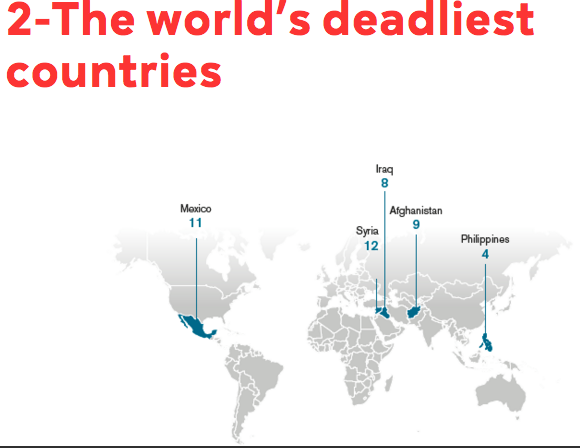MANILA – The Philippines was listed as the deadliest Asian country for reporters in 2017 – a year that was tagged “least deadly” for professional journalists in 14 years on account of a decline in total number of killings.
According to a report by the media watchdog Reporters Sans Frontieres (Reporters Without Borders), the total of 65 journalists killed in 2017 represented an 18% decline from the 2016 figure (79).
The RSF had bad news, however, insofar as the Philippine situation is concerned, declaring the country as Asia’s deadliest this year, despite its image as a regime of a free press.
The RSF report began its Philippine segment with: “Shortly after being elected president of the Philippines in May 2016, Rodrigo Duterte made this cryptic but alarming comment: ‘Just because you’re a journalist you are not exempted from assassination, if you’re a son of a bitch.’ The threat proved to be more than just talk in 2017, with at least five journalists targeted by gunmen. Four of them succumbed to their injuries.”
Thus, added RSF, the Philippines “resumed a grim trend going back more than decade — one that was interrupted only in 2016, an exceptional year in which no journalist was killed.”
65 KILLED WORLDWIDE
The tally of 65 fatalities worldwide for 2017 included: 50 professional journalists, 7 citizen-journalists and 8 media workers, said RSF. The number of professional journalists killed (50) was the lowest in 14 years.
Twenty-six of those felled worldwide in 2017 were killed in the course of their work, the collateral victims of a deadly situation such as an air strike, an artillery bombardment, or a suicide bombing. The other 39 were murdered, and deliberately targeted because their reporting threatened political, economic, or criminal interests. As in 2016, most of the deaths were targeted (60%). The aim in each case was to silence them, according to RSF.
DOWNWARD TREND EXPLAINED
RSF attributed the downward trend in total deaths worldwide in 2017 “in part to the many campaigns waged by international NGOs and media organizations on the need to provide journalists with more protection.”
More security training has helped to better prepare journalists for visits to hostile terrain, added RSF.
RSF also cited among the factors leading to the downward trend:
• Measures to improve the status of freelancers, with the goal of giving them the same kind of protection as staffers;
• Intensive lobbying of governments and international bodies by NGOs such as RSF that defend and protect journalists, the latest of which was adopted by the UN General Assembly on November 20, focused on the specific risks faced by women journalists in the exercise of their work and the need to address sexist discrimination, violence, and harassment, including online harassment;
• Journalists abandoning countries that have become too dangerous like Syria, Iraq, Yemen, and Libya; or journalists switching to a less dangerous profession.
Still, RSF said, “inability to report without risking one’s life is not limited to countries at war. Many journalists have either fled abroad or abandoned journalism in Mexico, where the criminal cartels and local politicians have imposed a reign of terror.”
DEADLIEST COUNTRIES IN 2017
Following a trend of the past six years, Syria remained the world’s deadliest country for journalists with 12 killed, but Mexico was close behind with 11 killed. All of them were deliberately targeted. Of countries not at war, Mexico was the deadliest for reporters in 2017, as it was last year.
Torn by a never-ending bloody war, Syria has been the world’s deadliest country for journalists since 2012. There is danger everywhere on the ground and journalists, professional or not, are permanently exposed to sniper fire, missiles, improvised explosive devices or suicide bombers. Syrian journalists are the most exposed, especially as the presence of foreign reporters has fallen sharply in recent years. Foreign reporters have nonetheless begun to return, especially to the north, to the Rojava region to cover the battles waged by Arab and Kurdish forces against Islamic State in Raqqa and Deir ez-Zor.
The same, said RSF, goes for Afghanistan, where nine national journalists were killed this year.
In Iraq, eight journalists were killed this year. Here too, it was local journalists who were targeted.
TWICE AS MANY WOMEN KILLED IN 2017
Ten women journalists were killed this year, compared to five last year. Many of the victims were experienced and determined investigative reporters with an abrasive writing style. Despite receiving threats, they continued to investigate and expose corruption and other cases involving politicians or criminal groups, and they paid for this with their lives, said RSF.










